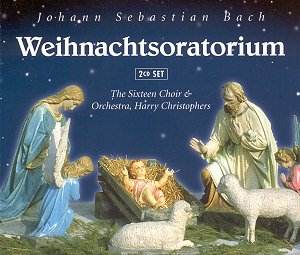Bach's 'Christmas Oratorio' presents perennial problems.
Is it an oratorio or a cycle of cantatas? From the first, Bach regarded
it as an oratorio, one which was performed in six parts. There was a
recognised tradition, in the German church, of performing multi-part
oratorios. Though few have come down to us, Bach would have known them.
But the difference between the 'Christmas Oratorio' and the Passions
is not just structural. The Passion story in the Gospels presented Bach
with many opportunities for dramatic narrative. The Nativity story in
the Gospels contains much less dialogue and what there is, Bach sets
in a non-dramatic fashion. The 'Christmas Oratorio' is a far more contemplative,
meditative work than either of the Passions.
I have always had a slight problem with the opening
of the first chorus. In this, and similar places in the oratorio, it
is all too easy for the flutes to sound under-powered as if they had
strayed in by accident. This is certainly true here, indicative perhaps
of a more overall malaise regarding orchestral balance. The timpani
seem over-loud and balance only when the chorus is singing. The organ
continuo is not always audible and can sound as if it is not connected
to the rest of the performers. John Eliot Gardiner’s recording on Archive
with the Monteverdi Choir and English Baroque Soloists presents this
first chorus with a far better integrated instrumental ensemble. Here
the balance sounds more convincing. Christophers' tempo is a only a
little slower than Gardiner's (7'49 as opposed to 7'40), but the Sixteen
sound merely steady and four-square whereas Gardiner succeeds in giving
the music shape and lift, with the welcome suggestion of one in a bar.
The first recitative introduces Mark Padmore's exemplary
Evangelist. Sung with absolute clarity of diction and with a consistently
mellifluous tone, Padmore is one of the best things on the recording.
In the following recitative sung by the Alto Catherine Wyn-Rogers, the
accompanying woodwind sound congested, almost uncoordinated. The woodwind
passages in the oratorio are important, whether solo or accompanying,
and too often they sound congested, lacking clarity and line. There
are a couple of moments, too, when the trumpets sound as if they are
tiring on their high trumpet parts. Something a little more time in
the studio could have rectified.
Catherine Wyn-Rogers sings the Alto solos with admirable
firmness. In 'Bereite dich, Zion' Christophers' tempo is merely plodding,
meandering at a jog-trot, rather than giving the aria space. Wyn-Rogers
is equally firm in 'Schlafe, mein Liebster, geniesse der Ruh', one of
the most lovely arias on the disk but Wyn-Rogers' tone sounds resolutely
earth-bound. I have happy memories of Paul Esswood on the Harnoncourt
recording on Teldec, and he brought to the role a clarity, transparency
and lightness that is all too lacking here. On the Gardiner recording,
Anne Sofie von Otter brings greater lightness and shape to the alto
arias but she has the advantage of Gardiner’s greater sense of shaping
the music.
Bass, Michael George, too frequently sounds a little
effortful in the arias, especially when compared to Olaf Bär's
mellifluous vocal character on Gardiner's recording. But George's meatier
tones do work well in some places - especially the recitatives. The
chorale and recitative in Cantata 1 works beautifully, though it does
rather show up poor diction of the choir. The soloists' diction is admirable
throughout, but in the chorales the choir seems to be sacrificing diction
for purity of tone. Admittedly they make a beautiful sound shaping the
chorale melodies, but at the expense of the words. And this is so noticeable
compared to diction of the soloists. The Sixteen are not alone in this
as Gardiner's Monteverdi Choir similarly fail to make enough of the
words in the chorales. As is to be expected, the Sixteen are at their
best in the choruses, providing some very exciting, shapely music making
as in the chorus 'Ehre sei dir, Gott!' which opens Cantata 5.
There are some lovely things here, the opening of Cantata
4 with the Chorus 'Fallt mit Danken' and recitatives leading in to the
Soprano echo aria 'Flösst, mein Heiland', nicely shaped by Soprano
Lynda Russell and echo Soprano Libby Crabtree along with the beautiful
solo oboe. These display the sort of relaxed music-making which this
recording does best. But in a number of places the fine detail of the
performance fails to live up to Christophers' conception.
This recording was first issued on the late, lamented
Collins Classics label, in 1993 and at that time it received some commendation
within the Gramophone, especially regarding Christophers’ ability to
balance the contemplative, meditative aspects with the more dramatic
sections. A comparison of timings between Gardiner and Christophers
is instructive. Overall, Christophers takes 6' longer than Gardiner.
Generally Christophers takes a more relaxed tempo than Gardiner; only
sometimes is he marginally faster. The end result gives the music time
to breathe, and this is one of the great advantages of the TFL set.
Despite Gardiner's faster speeds, his musicians frequently sound more
shapely and better integrated. Not everyone will like Gardiner's approach
to the music. He encourages the Monteverdi choir to sing some of the
chorales in a rather clipped and stylised way that will certainly not
be to everyone’s taste but the high standard of music making on the
Gardiner makes it a prime contender for your library recording.
TFL are to be congratulated on this reissue, but the
box is let down by its booklet. There isn't one. All you have is a track
listing of the CD. Because of my reservations this would not really
be my first choice recording, but it is definitely a recording to buy
to listen to when you want a rest from Gardiner's rather brisker approach
to the music.
Robert Hugill

